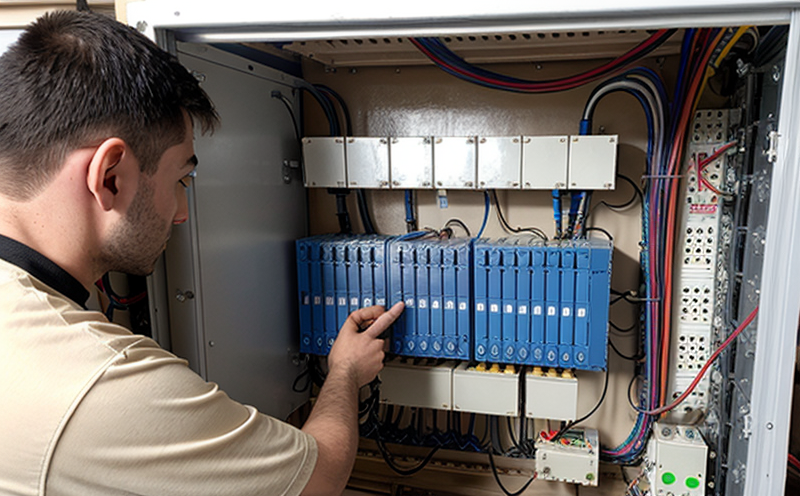Distribution board inspection
The distribution board is a critical component in any electrical installation. It plays a pivotal role by distributing electricity to various parts of a building or structure, ensuring that all devices receive the appropriate voltage and current levels without overloading. In construction and building inspection, ensuring the integrity and safety of these boards is paramount.
Inspection of distribution boards involves several key parameters such as checking for correct wiring, ensuring proper grounding, assessing the insulation resistance, verifying breaker ratings, and evaluating the overall condition of the board. The goal is to ensure that the distribution board complies with international standards like IEC 61439-2017 and EN 50178:2017.
During an inspection, it’s crucial to identify any potential hazards such as loose connections or damaged components. This not only enhances safety but also ensures that the electrical system operates efficiently. The process involves meticulous testing using specialized equipment like multimeters, insulation testers, and digital megohmmeters. These tools help in identifying issues early on, preventing costly repairs and ensuring compliance with building codes.
The importance of regular inspections cannot be overstated. They not only extend the life of the distribution board but also contribute significantly to occupant safety. By adhering to strict standards and conducting thorough checks, inspectors can prevent electrical fires, reduce maintenance costs, and ensure that all systems are functioning optimally.
In summary, a comprehensive inspection of distribution boards is essential for maintaining safe and efficient electrical installations. It involves meticulous testing and adherence to international standards. Regular inspections not only enhance safety but also extend the lifespan of the equipment and prevent costly issues down the line.
Benefits
The benefits of a robust distribution board inspection are numerous and far-reaching:
- Safety Assurance: Ensures that electrical systems operate safely, reducing the risk of fires and other hazards.
- Cost Savings: Prevents costly repairs by identifying issues early. Regular inspections can extend the life of equipment and reduce maintenance costs.
- Compliance: Ensures adherence to local and international standards, thereby avoiding penalties for non-compliance.
- Avoidance of Downtime: By maintaining proper functioning systems, you minimize unscheduled outages that can disrupt operations.
- Better Performance: Ensured that all electrical devices receive the correct voltage and current levels, leading to better performance across the board.
- Increased Efficiency: A well-maintained distribution board ensures efficient use of energy resources, which is crucial in today’s cost-conscious environment.
The cumulative effect of these benefits is a more reliable, safer, and more efficient electrical infrastructure that supports the overall operation and safety of any building or structure.
Customer Impact and Satisfaction
For customers involved in construction and building inspection, the impact of a thorough distribution board inspection can be profound. By ensuring that all systems are up to standard, inspections enhance customer satisfaction through:
- Increased Confidence: Clients receive peace of mind knowing their projects meet strict safety and performance standards.
- Enhanced Reputation: Delivering high-quality services can boost the reputation of any company involved in construction and building inspection.
- Improved Relationships: Satisfied customers are more likely to recommend your services, leading to new business opportunities and long-term relationships.
The impact extends beyond immediate project completion. By providing reliable services, companies can establish themselves as leaders in their field, attracting top talent and securing future contracts. This not only fosters customer satisfaction but also drives continuous improvement in quality and service delivery.
Use Cases and Application Examples
| Scenario | Description | Outcome |
|---|---|---|
| New Construction Project | A new commercial building is being constructed. The distribution board inspection ensures that all electrical systems are installed according to IEC 61439 and EN 50178 standards. | The project meets safety and performance benchmarks, ensuring the comfort and security of occupants. |
| Existing Building Upgrade | An existing office building undergoes a major renovation. The inspection identifies issues with old wiring that could lead to fires if left unaddressed. | The identified risks are mitigated, enhancing safety for employees and visitors. |
| New Apartment Complex | A new apartment complex is being built. The distribution board inspection ensures all electrical systems comply with local building codes. | Residents enjoy a safe living environment that meets the highest standards of quality and safety. |
| Industrial Facility Expansion | An industrial facility expands its operations, necessitating an upgrade to its existing electrical infrastructure. The inspection ensures compliance with EN 50178:2017. | The expansion is completed safely and efficiently, minimizing downtime and ensuring optimal performance of new systems. |
| Residential Home Renovation | A homeowner renovates their home, including upgrading the electrical system. The inspection ensures that all upgrades meet current safety standards. | The home’s electrical system is safe and reliable, providing peace of mind to the homeowner. |
| Commercial Building Retrofit | A commercial building undergoes a retrofit to improve energy efficiency. The distribution board inspection ensures compliance with IEC 61439:2008. | The retrofit is completed safely and efficiently, enhancing both safety and sustainability. |
| New School Construction | A new school is being constructed. The distribution board inspection ensures all electrical systems comply with EN 50178:2017. | The school’s facilities are safe and reliable, supporting the education of students. |
These use cases demonstrate how a thorough inspection can ensure compliance, enhance safety, and improve performance in various construction projects. By adhering to international standards, companies can deliver high-quality services that meet the needs of their clients and the broader community.





